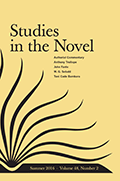
Johns Hopkins UniversityEst. 1876
America’s First Research University
Now Browsing:
Q&A with 'Studies in the Novel' Editors
The journal Studies in the Novel joined the Johns Hopkins University Press collection in 2014. Based at the University of North Texas, the journal has published incisive scholarship since its founding in 1965 by a group of UNT English professors. As a vehicle for critical reflection and social transformation, the novel remains what it always has been: a vital source of new ways of thinking and relating to a rapidly changing world. The journal continues to break new ground by promoting new theoretical approaches, a broader international scope, and an engagement with the contemporary novel as a form of social critique.
Now edited by Stephanie Hawkins along with managing editor Tim Boswell, Studies in the Novel has recently unveiled a new website at www.studiesinthenovel.org. The Marketing Department in the JHU Press Journals Division and the JHUP Information Technology staff worked with the editorial team to create the site, which will allow the quarterly to supplement the content published in the print edition. Hawkins and Boswell spoke with Brian Shea, Public Relations and Advertising Coordinator in Journals Marketing, about the new site. Brian Shea: What were your initial feelings when you saw the completed site? Stephanie Hawkins: My first thought was, wow, this is really exciting. I love how both the journal’s established reputation and revitalized vision—to publish “novel” scholarship on the novel—came together in the website’s bold design. To my mind, the website’s format and fluid design not only capture the novel’s world-making possibilities, but also invite further exploration and discovery, the very things I hope this website helps inspire in the field at large. Tim Boswell: My reaction was really similar. I was excited to see a site that, from a technical and design standpoint, I felt was the equal to anything in the field. Too often scholarly and academic websites fail to reflect the appreciation for beauty and engagement that truly—for many of us—drove us to love books and ideas in the first place. BS: What encouraged you to look into a new site for Studies in the Novel? SH: Certainly I felt it was time to give our nearly fifty-year-old journal a fresh look and feel, but I also wanted to have a dynamic site that could capitalize on social media, blogging, and pod and videocasts in order to create a more publicly accessible space to promote scholarly exchange and support the innovative teaching of new and canonical novels. TB: A digital presence can provide so much more than simply another venue for stating information in the same static way that it might be presented if printed. We knew we wanted a site with a look and layout that would allow for a visual sensibility and interaction of the type offered by many commercial sites. As Stephanie pointed out, the journal may have been around for nearly half a century, but our website shouldn’t look like it has, too.
 Stephanie Hawkins, an associate professor in the department of English at the University of North Texas, began her tenure as editor of Studies in the Novel in January 2013. The author of American Iconographic: National Geographic, Global Culture, and the Visual Imagination (University of Virginia Press, 2010), her scholarly work focuses on the interface between public attitudes, literary and visual representation, and institutional rhetorics.
Timothy Boswell has been managing editor at Studies in the Novel since June 2012, and in 2014 he earned university-wide recognition for his work at the journal.
Stephanie Hawkins, an associate professor in the department of English at the University of North Texas, began her tenure as editor of Studies in the Novel in January 2013. The author of American Iconographic: National Geographic, Global Culture, and the Visual Imagination (University of Virginia Press, 2010), her scholarly work focuses on the interface between public attitudes, literary and visual representation, and institutional rhetorics.
Timothy Boswell has been managing editor at Studies in the Novel since June 2012, and in 2014 he earned university-wide recognition for his work at the journal.
Login to View & Leave Comments
Login to View & Leave Comments



